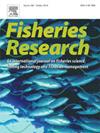Influence of phospholipid and LC- PUFA content in extruded micro diets on European lobster larval (Homarus gammarus) performance and nutritional composition
IF 2.2
2区 农林科学
Q2 FISHERIES
引用次数: 0
Abstract
Requirement of lipids and long chain polyunsaturated fatty acids (LC PUFAs) on larval performance and development of European lobster is partly unknown. The effects of replacing live feed (Artemia nauplii) with two formulated extruded diets with different content of phospholipids and LC PUFAs were demonstrated for larval culture of European lobster Homarus gammarus obtained by supplementation of soy lecithin, salmon oil, krill oil and arachidonic acid (Croda) and fish oil (DHA 70). The isonitrogenous and isoenergetic diets; (low phospholipid; low PUFA), LPP and (high phospholipid high PUFA), HPP)had a phospholipid content of 3 % and 12 %- and a LC- PUFA content of 1 % and 4.8 %, respectively. Newly hatched larvae were distributed into triplicate conical transparent tanks of 46 L each with 250 larvae per tank. Two additional groups one fed with Artemia (AF type) and one group left unfed were used as controls. Temperature was 19.5 °C. Lobster larvae were fed twice daily for 18 days. Every three days, all larvae in each tank were counted and at 14 days post hatch 10 larvae per tank were sampled and subsequently frozen at −80°C for subsequent, fatty acid (FA) composition and lipid content. Survival and growth were significantly different between groups, lowest for unfed larvae and highest for Artemia. The highest number of stage IV post-larvae were obtained by Artemia followed by diets HPP and LPP, while only a few larvae survived in the unfed group until end of experiment. Lipid and FA composition in larvae were significantly related to dietary composition. Results showed, that although cannibalism persists as an over-riding factor in survival, appropriate dietary lipid composition is of importance in early larval stages and influence on survival and performance to post-larvae.
挤压微饲料中磷脂和LC- PUFA含量对欧洲龙虾幼体生产性能和营养成分的影响
脂类和长链多不饱和脂肪酸(LC PUFAs)对欧洲龙虾幼体生产性能和发育的影响尚不清楚。以添加大豆卵磷脂、鲑鱼油、磷虾油、花生四烯酸(Croda)和鱼油(DHA 70)获得的欧洲大龙虾(Homarus gammarus)幼体为试验材料,研究了用两种不同磷脂和LC PUFAs含量的膨化饲料替代活饲料(Artemia nauplii)的效果。等氮等能日粮;(低磷脂;低PUFA)、LPP和(高磷脂高PUFA)、HPP的磷脂含量分别为3 %和12 %,LC- PUFA含量分别为1 %和4.8 %。新孵化的幼虫分布在3个锥形透明池中,每个池46 L,每个池250只幼虫。另设两组作为对照,一组饲喂青蒿(AF型),另一组不饲喂。温度为19.5℃。每天投喂两次龙虾幼虫,连续投喂18 d。每隔三天对每个鱼缸中的所有幼虫进行计数,孵化后第14天,每个鱼缸取样10只幼虫,随后在- 80°C冷冻,用于后续的脂肪酸组成和脂质含量。各组间存活率和生长差异显著,未饲喂幼虫最低,青蒿最高。4期后幼虫数量以青蒿素组最高,其次为饲粮HPP和LPP,未饲喂组至试验结束仅成活少量幼虫。幼虫脂肪和FA组成与饲料组成显著相关。结果表明,尽管同类相食仍然是影响成活的重要因素,但适当的饲料脂肪成分在幼虫早期也很重要,并影响幼虫后期的成活和生产性能。
本文章由计算机程序翻译,如有差异,请以英文原文为准。
求助全文
约1分钟内获得全文
求助全文
来源期刊

Fisheries Research
农林科学-渔业
CiteScore
4.50
自引率
16.70%
发文量
294
审稿时长
15 weeks
期刊介绍:
This journal provides an international forum for the publication of papers in the areas of fisheries science, fishing technology, fisheries management and relevant socio-economics. The scope covers fisheries in salt, brackish and freshwater systems, and all aspects of associated ecology, environmental aspects of fisheries, and economics. Both theoretical and practical papers are acceptable, including laboratory and field experimental studies relevant to fisheries. Papers on the conservation of exploitable living resources are welcome. Review and Viewpoint articles are also published. As the specified areas inevitably impinge on and interrelate with each other, the approach of the journal is multidisciplinary, and authors are encouraged to emphasise the relevance of their own work to that of other disciplines. The journal is intended for fisheries scientists, biological oceanographers, gear technologists, economists, managers, administrators, policy makers and legislators.
 求助内容:
求助内容: 应助结果提醒方式:
应助结果提醒方式:


